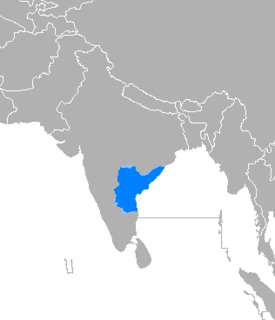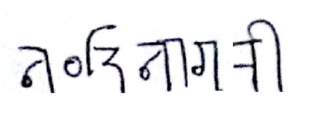
Telugu is a Dravidian language spoken predominantly in the Indian states of Andhra Pradesh and Telangana and the Union Territory of Puducherry (Yanam) by the Telugu people. It stands alongside Hindi and English as one of the few languages with primary official language status in more than one Indian state. Telugu is also a linguistic minority in the states of Orissa, Karnataka, Tamil Nadu, Kerala, Chattisgarh, Jharkhand and Maharashtra. It is one of six languages designated a classical language of India by the country's government.

The Brahmic scripts are a family of abugida writing systems. They are used throughout the Indian subcontinent, Southeast Asia and parts of East Asia, including Japan in the form of Siddhaṃ. They are descended from the Brahmi script of ancient India, and are used by languages of several language families: Indo-European, Dravidian, Tibeto-Burman, Mongolic, Austroasiatic, Austronesian, and Tai. They were also the source of the dictionary order (gojūon) of Japanese kana.
Telugu script, an abugida from the Brahmic family of scripts, is used to write the Telugu language, a Dravidian language spoken in the Indian states of Andhra Pradesh and Telangana as well as several other neighbouring states. The Telugu script is also widely used for writing Sanskrit texts and to some extent the Gondi language. It gained prominence during the Eastern Chalukyas also known as Vengi Chalukya era. It shares extensive similarities with the Kannada script, as it has evolved from Kadamba and Bhattiprolu scripts of the Brahmi family. Both Adikavi Pampa of Kannada and Adikavi Nannayya of Telugu hail from families native to the Vengi region. In 2008, Telugu language is given the status of Classical Languages of India, this status owes to its rich history and heritage.

The Gondi (Gōndi) or Gond or Koitur are an Indian ethnic group. They speak Gondi language which is a Dravidian language. They are one of the largest tribal groups in India. They are spread over the states of Madhya Pradesh, eastern Maharashtra (Vidarbha), Chhattisgarh, Uttar Pradesh, Telangana, Andhra Pradesh, Bihar and Odisha. They are listed as a Scheduled Tribe for the purpose of India's system of positive discrimination. They are an Adivasi group of India

Telangana is a state in India situated on the centre-south stretch of the Indian peninsula on the high Deccan Plateau. It is the twelfth largest state and the twelfth-most populated state in India with a geographical area of 112,077 km2 (43,273 sq mi) and 35,193,978 residents as per 2011 census. On 2 June 2014, the area was separated from the northwestern part of Andhra Pradesh as the newly formed 29th state with Hyderabad as its historic permanent capital. Its other major cities include Warangal, Nizamabad, Khammam and Karimnagar. Telangana is bordered by the states of Maharashtra to the north, Chhattisgarh to the east, Karnataka to the west, and Andhra Pradesh to the east and south. The terrain of Telangana region consists mostly of hills, mountain ranges, and thick dense forests covering an area of 27,292 km2 (10,538 sq mi). As of 2019, the state of Telangana is divided into 33 districts.

Adivasi is the collective term for tribes of the Indian Subcontinent, who are considered indigenous to places within India wherein they live, either as foragers or as tribalistic sedentary communities. However, India does not recognise Tribe as Indigenous people. The term is also used for ethnic minorities, such as Chakmas of Bangladesh, Tharus of Nepal, and Bhils of Pakistan.

Gondi (Gōndi) is a South-Central Dravidian language, spoken by about two million Gondi people, chiefly in the states of Madhya Pradesh, Gujarat, Telangana, Maharashtra, Chhattisgarh, Andhra Pradesh and in various adjoining areas of neighbouring states. Although it is the language of the Gond people, only one fifth of Gonds can speak the language, making it vulnerable to extinction. Gondi has a rich folk literature, examples of which are marriage songs and narrations.

The Śāradā, Sarada or Sharada script is an abugida writing system of the Brahmic family of scripts. The script had its existence 1700 years ago but was widespread between the 8th and 12th centuries in the northwestern parts of India, for writing Sanskrit and Kashmiri. Originally more widespread, its use became later restricted to Kashmir, and it is now rarely used except by the Kashmiri Pandit community for religious purposes.

Komaram Bheem was a Telugu Indian tribal leader who fought against the Asaf Jahi Dynasty for the liberation of Hyderabad. Komaram Bheem openly fought against the ruling Nizam government in a guerrilla campaign. He defied courts, laws, and any other form of Nizam authority, living off the sustenance of the forest. He took up arms against Nizam Nawab's soldiers, and fought Babi Jhari until his last breath. His life history was written originally by the comrade leader of Telangana Rebellion, Puchalapalli Sundariah.
Anabheri Prabhakar Rao was a Telangana guerrilla leader and is also considered a foremost authority of the Telugu language. He was an Indian freedom fighter, considered to be one of the most influential revolutionaries of the Indian independence movement. He was an intellectual, military theorist, diplomat and major figure of the Telangana Rebellion. He died fighting against the Nizam and Razakars.

Samaikya Andhra Movement was a movement organized to keep the Indian state of Andhra Pradesh united, and to prevent the division of the state - separating the Telangana districts of the state into a separate Telangana state. The movement was supported by government employees, advocates in Coastal Andhra & Rayalaseema regions along with students from 14 universities, various occupational, caste & religious groups of Coastal Andhra & Rayalaseema regions. The last set of protests were triggered after the Congress Working Committee decision to divide the state came to an end after President of India gave nod to Telangana Bill which would make the latter to come into existence from 2 June 2014.

Nandinagari is a Brahmic script derived from Nāgarī script which appeared in the 7th century AD. This script and its variants were used in the central Deccan region and south India, and an abundance of Sanskrit manuscripts in Nandinagari have been discovered but remain untransliterated. Some of the discovered manuscripts of Madhvacharya of the Dvaita Vedanta school of Hinduism are in Nandinagari script.

The Adilabad district is located in the northern region of Telangana, India. It is known as the gateway district to South and Central India. The city of Adilabad is the headquarters of the Adilabad district.

Telugu language policy is an issue in the Indian states of Andhra Pradesh and Telangana, with 84 percent of the population reporting Telugu as their first language in Andhra Pradesh prior to the creation of the State of Telangana within the Indian Union. Telugu-language advocates note a lack of incentivisation and government support for the language, and press for their linguistic rights for Telugu's greater recognition and promotion.
Telugu is a Unicode block containing characters for the Telugu, Gondi, and Lambadi languages of Telangana and Andhra Pradesh, India. In its original incarnation, the code points U+0C01..U+0C4D were a direct copy of the Telugu characters A1-ED from the 1988 ISCII standard. The Devanagari, Bengali, Gurmukhi, Gujarati, Oriya, Tamil, Kannada, and Malayalam blocks were similarly all based on their ISCII encodings.
Gondi has typically been written in Devanagari script or Telugu script, but native scripts are in existence. A Gond by the name of Munshi Mangal Singh Masaram designed a Brahmi-based script in 1918, and in 2006, a native script that dates up to 1750 has been discovered by a group of researchers from the University of Hyderabad.

Gunjala is a village in the Adilabad district of Telangana, India.

Komaram Bheem Asifabad is a census town and the district headquarters of Komaram Bheem district in the Indian state of Telangana. It is located in Komaram Bheem Asifabad mandal of Komaram Bheem Asifabad revenue division. It is named after Gond martyr Komaram Bheem. It is situated on the banks of Peddavagu river.
Masaram Gondi is a Unicode block containing characters from the Masaram Gondi script, which was designed for writing Gondi in 1918 by Munshi Mangal Singh Masaram, a Gond from Balaghat district of Madhya Pradesh, India.
Gunjala Gondi is a Unicode block containing characters of Gunjala Gondi script used for writing the Adilabad dialect of the Gondi language.














